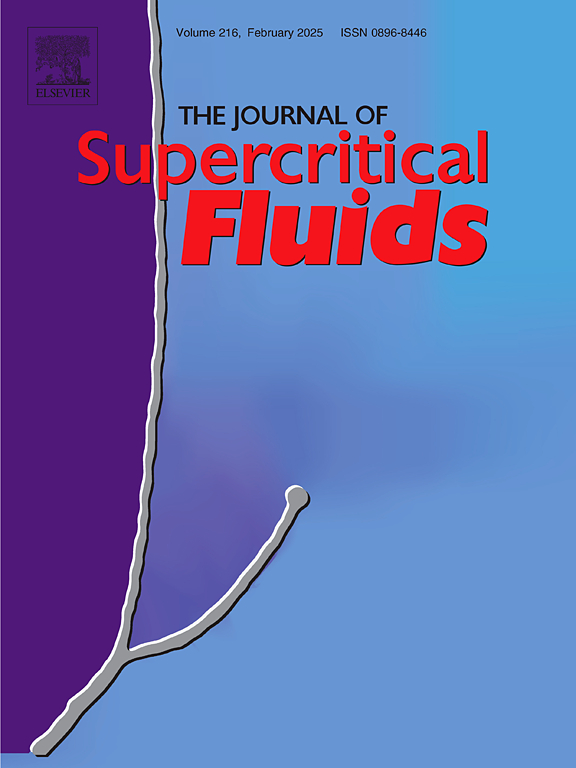浸没管超临界CO2流化床反应器中CaO颗粒碳酸化的数值研究
IF 4.4
3区 工程技术
Q2 CHEMISTRY, PHYSICAL
引用次数: 0
摘要
钙环热化学储能系统与超临界二氧化碳(SCO2)布雷顿循环的集成为提高聚光太阳能电站的能量转换效率提供了一种很有前途的技术方案。碳酸化反应器仍然面临着多循环碳化-煅烧反应中反应性严重下降等挑战。本研究提出了一种以sCO2为流化剂的新型解决方案,以提高流化质量,避免CaO/CaCO3颗粒在碳化反应器中团聚和烧结。采用欧拉-欧拉双流体模型,研究了总气压和CO2分压对流态化质量、床管传热系数(HTC)和碳化反应的影响。结果表明,将气体压力提高到CO2临界压力以上,可导致Geldart b型ca基颗粒流态化。当使用sCO2时,可以获得更均匀的局部床-管HTC分布,但降低了周向平均HTC(减少45-119 W∙m−2∙K−1)。CO2分压从40 kPa提高到4000 kPa,转化率提高了近1000倍,说明需要进行特殊设计来处理超临界压力流化床反应器内部潜在的超温问题。本文章由计算机程序翻译,如有差异,请以英文原文为准。
Numerical investigation on the carbonation of CaO particles in a supercritical CO2 fluidized bed reactor with immersed tubes
The integration of calcium-looping thermochemical energy storage system with the supercritical carbon dioxide (SCO2) Brayton cycle offers a promising technical scheme to improve the energy conversion efficiency of the concentrated solar power plant. The carbonation reactor still faces challenges such as a serious decline in reactivity during multicycle carbonation-calcination reactions. In this study, a novel solution using sCO2 as the fluidizing agent to improve the fluidization quality and avoid the agglomeration and sintering of CaO/CaCO3 particles in a carbonation reactor is proposed. The effects of total gas pressure and CO2 partial pressure on the fluidization quality, bed-to-tube heat transfer coefficient (HTC), and carbonation reaction are investigated by using the Eulerian−Eulerian two-fluid model. The results indicate that increasing the gas pressure above the CO2 critical pressure leads to the particulate fluidization of Geldart B-type Ca-based particles. A more uniform distribution of local bed-to-tube HTC around the tube but with a reduced circumferential average HTC (by 45–119 W∙m−2∙K−1) is achieved when using sCO2. An increase of CO2 partial pressure from 40 to 4000 kPa leads to a nearly 1000-fold increase in conversion rate, indicating that special designs are necessary to handle the potential over-temperature problem inside the supercritical pressure fluidized bed reactor.
求助全文
通过发布文献求助,成功后即可免费获取论文全文。
去求助
来源期刊

Journal of Supercritical Fluids
工程技术-工程:化工
CiteScore
7.60
自引率
10.30%
发文量
236
审稿时长
56 days
期刊介绍:
The Journal of Supercritical Fluids is an international journal devoted to the fundamental and applied aspects of supercritical fluids and processes. Its aim is to provide a focused platform for academic and industrial researchers to report their findings and to have ready access to the advances in this rapidly growing field. Its coverage is multidisciplinary and includes both basic and applied topics.
Thermodynamics and phase equilibria, reaction kinetics and rate processes, thermal and transport properties, and all topics related to processing such as separations (extraction, fractionation, purification, chromatography) nucleation and impregnation are within the scope. Accounts of specific engineering applications such as those encountered in food, fuel, natural products, minerals, pharmaceuticals and polymer industries are included. Topics related to high pressure equipment design, analytical techniques, sensors, and process control methodologies are also within the scope of the journal.
 求助内容:
求助内容: 应助结果提醒方式:
应助结果提醒方式:


